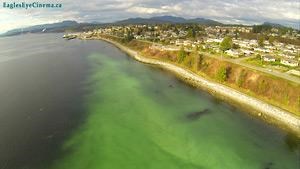White, milty water off Donkersley Beach was the first sure sign, last week, that Powell River would be visited again by one of the coast’s most mysterious fish.
Last year was the first year in three decades herring returned to spawn on Powell River’s shores.
Anticipation had been building on whether they would return. “I was hoping they would spawn again,” said Palm Beach area resident and marine photographer Terry Brown. “But there’s nothing certain in nature.”
Over the following days, the patches of sometimes emerald green water moved north up the coast. On Tuesday, March 17, it could been seen in front of the Westview viewpoint.
The return of herring has caused quite a stir, not only for human beings who are excited to see the water sometimes boil with movement, but also a number of sea lions and sea birds who feed on the stock.
Last year was the first time herring spawned on the coast since the early 1980s when overfishing the small silvery fish nearly wiped stocks out.
Brown noted that while the fish were somewhat early on the eastern side of Vancouver Island, they were about a week later than last year on the Upper Sunshine Coast.
There is something of a disagreement between the federal government and First Nations over whether the fish are purely migratory or if there are resident stocks which return to specific places to spawn each year, Brown said.
He added that over the last few years many of the resident stocks which spawned in Howe Sound and Lower and Upper Sunshine Coast have rebounded to the point now where their spawning is noticeable. Herring are one of a few fish that make up the base of the marine food chain. With their return, coastal residents are noticing more whales, dolphins and other activity in Malaspina Strait.
With the return of the herring, Brown, as well as others, is concerned that it could encourage the Department of Fisheries and Oceans to open a commercial fishery again.
“We want salmon and we want whales here, therefore we should also want to have lots of herring here,” Brown said. Because the herring are keystone species they play an important role in providing a food source for other marine species. “Herring feed all these amazing beings that people love to see.”
Brown added if local people want to protect the herring they may have to take a stand similar to the way the Heiltsuk First Nation on BC’s central coast has actively blocked the herring fishery near Bella Bella.
Last year, Heiltsuk boats blockaded the herring boats disrupting the commercial opening. This year, out of concern for the recovering stock, the first nation has decided to not have their own opening.
“The Heiltsuk Nation owns two gillnet licences, but we will not be leasing them this year due to conservation concerns,” wrote Heiltsuk Chief Councillor Marilyn Slett in an open letter to Jim Pattison who, among other commercial ventures, operates fishing boats on the Central Coast. “In a community with high unemployment such as ours, this decision was not taken lightly. It is a sacrifice we must make now in order to safeguard for our future.”
Brown added, there is also a movement for sport fishery groups to buy up the herring roe fishery licences and then not use them. “This is taking responsibility for our own areas,” he said. “If the government is not going to do it then we have to do it ourselves.”
Readers can watch a video by Jeremy Williams of the herring spawn on Youtube.



